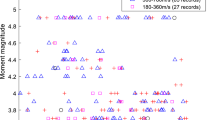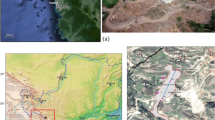Abstract
Seismic hazard assessment is done for oil field areas in the North Caspian region by a method earlier successfully applied to other areas. The method involves general seismic zoning data, available regional databases on recurrence of seismic shaking, known models of ground motion attenuation in seismoactive regions, and data on geological and geophysical surveys in the studied area. The assigned level of seismic hazard of the region is refined using probabilistic analysis; additionally, disaggregation is made and accelerograms are synthesized (the latter are necessary for seismic microzoning of particular sites using the numerical nonlinear analysis of ground seismic response). The amplitude and spectral characteristics of ground motions are obtained which are necessary for seismic resistance design and construction of petroleum industry objects.
Similar content being viewed by others
References
A Report of the Shirshov Institute of Oceanology, Russian Academy of Sciences within Agreement No. 4577 between Lukoil-VolgogradNIPImorneft Company and Shirshov Institute of Oceanology “Correction of Engineering-Geological Profiles and Maps of the Sea Depths along the Routs of Submerged Pipelines from the Riser Block (RB) of the Filanovskiy Field to LSP-1 of the Korchagin Field”, (Moscow, 2010) [in Russian].
A Report of the Caspian Branch of the Shirshov Institute of Oceanology, Russian Academy of Sciences on the Results of the Second Stage within the Agreement No. 12V0474 between Lukoil-Nizhnevolzhskneft and Shirshov Institute of Oceanology “The Data Processing of Seismological Observation on Geodynamic Area of the Korchagin Field”, (Astrakhan, 2012) [in Russian].
SNiP (Building Code) II-7–81*: Construction Norms and Rules. Part 2, Ch. 7: Construction in Seismically Active Regions (Federal Center of Standardization, Moscow, 2014) [in Russian].
V. I. Ulomov, L. S. Shumilina, and K. N. Akatova, Electron database on recurrence of seismic shakes with different intensity in Northern Eurasia. 2014 http://seismosu.ifz.ru/electr-earth.htm
N. A. Abrahamson and W. J. Silva, “Summary of the Abrahamson & Silva NGA ground-motion relations,” Earthquake Spectra 24 (1), 67–97 (2008).
J. P. Bardet, K. Ichii, and C. H. Lin, EERA: A Computer Program for Equivalent Linear Earthquake Site Response Analysis of Layered Soils Deposits: Software Manual (University of Southern California, Los Angeles, CA, 2000).
J. P. Bardet and T. Tobita, NERA: A Computer Program for Nonlinear Earthquake Site Response Analyses of Layered Soil Deposits: Software Manual (University of Southern California, Los Angeles, CA, 2001).
P. Bazzuro and C. A. Cornell, “Disaggregation of seismic hazard,” Bull. Seismol. Soc. Am. 89 (2), 501–520 (1999).
B. Bender and D. M. Perkins, “SEISRISK II: a computer program for seismic hazard estimation,” in U.S. Geological Survey Open-File Report 82–293 (U.S. Governmental Printing Office, Washington, DC, 1982).
B. Bender and D. M. Perkins, SEISRISK III: A Computer Program for Seismic Hazard Estimation, U.S. Geol. Surv. Bull. (U.S. Governmental Printing Office, Washington, DC, 1987).
K. W. Campbell and Y. Bozorgnia, “NGA ground motion model for the geometric mean horizontal component of PGA, PGV, PGD, and 5% damped linear elastic response spectra for periods ranging from 0.01 to 10 s,” Earthquake Spectra 24 (1), 139–171 (2008).
M. C. Chapman, “A probabilistic approach to ground motion selection for engineering design,” Bull. Seismol. Soc. Am. 85 (3), 937–942 (1995).
Y. M. A. Hashash, DEEPSOIL V. 3.7: Tutorial and User Manual, 2002–2009 (University of Illinois, Urbana, IL, 2009).
N. C. Nigam and P. C. Jennings, “Calculation of response spectra from strong-motion earthquake records,” Bull. Seismol. Soc. Am. 59 (2), 909–922 (1969).
F. Sabetta and A. Pugliese, “Estimation of response spectra and simulation of nonstationary earthquake ground motions,” Bull. Seismol. Soc. Am. 86, 337–352 (1996).
P. B. Schnabel, J. Lysmer, and H. B. Seed, “SHAKE: a computer program for earthquake response analysis of horizontally layered sites,” in Report No. UCB/EERC28–72/12 (Earthquake Engineering Research Center, University of California, Berkeley, 1972).
V. I. Ulomov, Earthquake source zones of Northern Eurasia–GSHAP region 7. http://www.seismo.ethz.ch/static/gshap/neurasia/source_zones.ans
Author information
Authors and Affiliations
Corresponding author
Additional information
Original Russian Text © A.A. Krylov, A.I. Ivashchenko, S.A. Kovachev, 2015, published in Okeanologiya, 2015, Vol. 55, No. 6, pp. 1006–1012.
Rights and permissions
About this article
Cite this article
Krylov, A.A., Ivashchenko, A.I. & Kovachev, S.A. Seismic hazard assessment for oil-and-gas-bearing shelf zones: A case study of the North Caspian region. Oceanology 55, 910–915 (2015). https://doi.org/10.1134/S0001437015060089
Received:
Published:
Issue Date:
DOI: https://doi.org/10.1134/S0001437015060089




